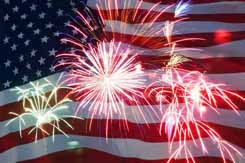
Every year during this special holiday week, our nation celebrates its independence in a variety of ways. Picnics, family outings and barbeques are just of few of the fun activities we all look forward to sharing with our loved ones.
As a nurse who has worked in the ER for nearly 30 years, I am also acutely aware of the danger that one of our most beloved 4th of July traditions can bring. In our attempt to celebrate with a “BANG!”, we often overlook the importance of fireworks safety, yet overlooking this important step in planning your celebration can have devastating (and lasting) consequences.
From 2007 through 2011 there were 4,143 fireworks-related emergency incidents in Washington State, with a five-year-average of 829 incidents annually. Types of injuries that we see in the ER include lacerations, burns, amputated fingers/toes/hands and arms (depending on the power of the explosive device), and inhalation injuries (which affect your ability to breathe). I don’t think I have to tell you the pain and suffering involved in any of these injuries—but this is especially hard on everyone when it involves children. I would like to give you a few safety tips to help keep you and your families out of the ER this year—and as much as we love taking care of you, we are more interested in helping you prevent the need for an ER visit.
Fireworks Safety Tips
Be Prepared – Have water nearby and put pets indoors,
Be Safe – Only adults should light fireworks
Be Responsible – Clean up fireworks debris
Take Responsibility
– Don’t overestimate your child’s ability to use good judgment.
– Set family boundaries. Only adults should light fireworks.
– Children are naturally curious. Be sure fireworks, matches and lighters are secured out of sight and reach of children.
– Be sure to discharge all fireworks devices so there are no leftovers to tempt curious children.
– M80’s, M100’s or M1000’s are not fireworks; they are illegal explosive devices. They can cause amputations or other severe injuries and possessing them has legal consequences (these are the devices that we see cause the most damage in the ER.)
Before you light fireworks — Be prepared
– Purchase only legal fireworks, available at approved stands.
– Talk with family members and guests about laws in your area.
– Place pets indoors; they may become frightened.
– Keep a bucket of water nearby to place used fireworks inside.
– Have a water hose or fire extinguisher nearby to put out any stray sparks from fireworks.
– Know the emergency number to call for your area, your home address/location, and basic first aid.
When lighting fireworks — Be safe
– Follow family boundaries, only a designated adult should light all fireworks.
– Light one at a time, move away quickly, and keep at a safe distance until the display is finished.
– Use only outdoors, away from anything that can burn.
– To prevent injuries, never throw fireworks and never hold fireworks in your hand.
After you finish — Be responsible
– Clean up all debris.
– If a device does not light or fire, an adult should wait at least fifteen minutes and approach it carefully.
– Place the device in a bucket of water to soak.
– Be sure all unused fireworks matches and lighters are out of the sight and reach of children.
Take it from someone who’s spent many years working in Emergency Services on this special holiday: for the sake of your family and for your own well-being, please go easy on the fireworks this year. Celebrate our freedoms injury-free! It will be a much more enjoyable holiday without the added drama of a trip to your local ER.
Happy 4th everyone!
For more information: http://www.wsp.wa.gov/fire/fireworks.htm


Great Article